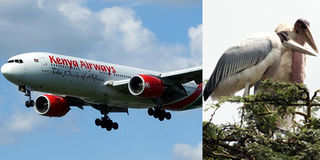Birds of a feather who never see eye to eye

Photo/FILE
Kenya Airways at one time spent Sh315 million to repair an engine after a bird strike.
There is much to learn from the “undertaker” birds which several years ago — just like human beings — decided to leave their rural habitats and seek a better life in towns.
The bird, also known as the Marabou Stork, came looking for dirtier pastures which it found in plenty; but it has also learnt that the city is no bed of acacia trees.
“Initially the Marabou Stork bred and lived in Wajir, but it has since become urbanised because of the many open dump sites to be found in towns,” says Dr George Amutete, head of the wildlife control unit at the Kenya Airports Authority.
The decision to come to the city, says Dr Amutete, was a bad one because the clumsy bird is hardly equipped for town life and has become one of the biggest dangers to air travel.
Major threat
Dr Amutete gives the example of Mwakirunge dump site which is on the path of aircraft using Mombasa International Airport.
“The bird and others foraging at the site are a major threat to aeroplanes landing or taking off,” says Dr Amutete.
He tells of one incident where Kenya Airways spent Sh315 million to repair an engine after a bird strike.
Recently the undertaker and the crow — a similarly dangerous bird to aeroplanes — were at the centre of deliberations at an international conference held in Kisumu by the airline industry.
Although described as “lazy and stupid” by pilots, the aviation industry has borrowed heavily from the “undertaker” especially the makers of big jets.
Unlike the smaller birds which take of immediately on sensing an approaching plane, the Marabou will trot for some distance along the ground to gain speed — just like the plane does.
This delayed flight could lead to a collision between bird and machine. And while nature has given the bird hallow leg and toe bones to help in take-off, this does not look good enough.
Things can get worse if there is a grass fire near an airport because the bird has the tendency to march in front of the advancing fire, grabbing animals that are fleeing.
But if the Marabou is a threat to planes from its clumsiness and “stupidity”, at the end other end of the scale is the crow that becomes a danger to itself and aeroplanes for its “cleverness”.
The crow, said to have a fantastic memory, and ranked as the eighth most intelligent non-human animal, is both a darling and nightmare of pilots.
It is admired by even the most ardent fighter pilots for its antics and agility in the air, some more advanced than what the Kenya Air Force display with their F5s during national days.
The long legged bird is known to climb to great heights and then fall earthward in a series of rolls and tumbles before catching themselves and doing it all over again.
Even surprised by a most modern jetliner travelling at more than 300 meters per second, explains Dr Amutete, the crow can react much faster and get out of the way.
“But just like most intelligent beings, it has a major flaw. It is aggressive and will constantly get in fights with other birds hence losing concentration and a sense of approaching objects,” says Dr Amutete, a bird specialist.
Repair costs
Apart from repair costs, he says, a direct impact between a big bird or a flock and fast moving airliner can potentially rip off a wing or engine and bring down a plane.
Kenya Airports Authority, which was hosting the Kisumu conference, says it’s carrying out a campaign to scare away the birds from all its airports.
“Through ‘Operation Hamisha Ndege’ we have employed and trained scouts who chase away the birds from airports’ vicinity.
“We are also planting trees, as bird hosts near our facilities as is happening around Eldoret Airport,” says Mr Dominic Ngige, head of corporate affairs at KAA.
While humans may not be able to tell individual crows apart, research indicates the birds can tell one humans from each other.
With this intelligence crows and other intelligent birds are able to soon learn that a certain control measure such as a scare gun are not for real and can be ignored.
To show the birds how serious the noise making guns are, a blast is followed by a recorded cry of a bird in pain.
“But even this cannot be used for long because they soon learn it is only a trick,” says Dr Amutete told the Nation.
Local birds, just like other Kenyans, have been known to aggressively protect their ancestral lands.
“When migrant birds from Europe try to settle, they meet hostile reception, and have to free to the nearest open spaces — airport,” says Dr Amutete.




